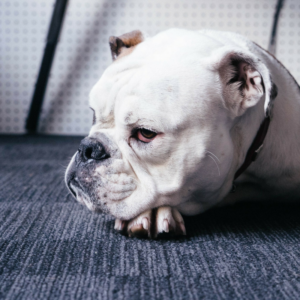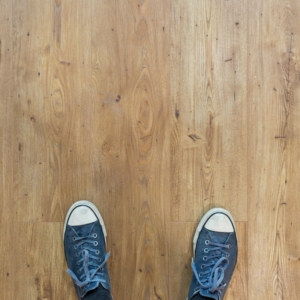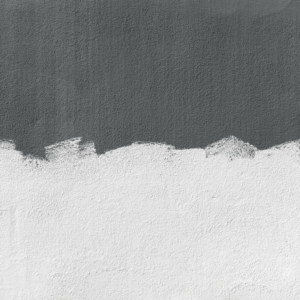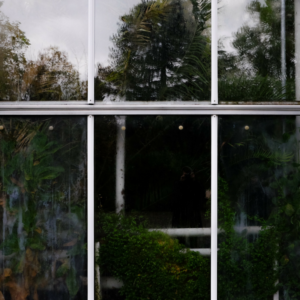
Grab five random landlords off the street and ask them:
“Who is harder on their homes, renters or homeowners?”
To say that the poll results would be predictable and one-sided would be a gross understatement.
Tenants simply have less invested in their home than homeowners do. At the simplest level, it’s the difference between a $1,200 security deposit and a $20,000 down payment.
But it goes deeper than that – most tenants plan to move away in a year or two, while most homeowners buckle down for the long haul. Homeowners are emotionally invested, not just financially invested.
How can landlords protect their hard-earned assets against the inbound Hurricane Renter? Even if you hire a property manager, this kind of advance planning and prevention is beyond their wheelhouse and service level.
Here are eight tactics I’ve used over the years to fortify my rental properties against careless renters, their wild children, and their (hopefully) domesticated animals.
1. Use Hardwood Substitutes, Not the Real McCoy

It’s also expensive, and delicate. Unless you buy outrageously expensive planks made of woods like mahogany or rainforest hardwood, hardwood floors will scratch. (Prepare for the eco-police to show up at your door if you install rainforest hardwood, too.)
Instead, consider either bamboo or high-end laminate wood. They’re less expensive, more resilient, and more mold-resistant than hardwood.
They also look beautiful, obviously a high priority!
2. Avoid Carpets, Too
Carpets are not a landlord’s friend.
They stain easily, they hold odors and their lifespan is short, as they rapidly discolor and show wear and tear.
Have tenants with pets? Pet fur and dander is extremely difficult to remove from carpeting. Read: allergen nightmare for the next set of renters.
Oh, and they’re fertile breeding grounds for mold and mildew. If your property sees any water damage, think “house-sized petri dish.”
So what should you use instead? Bamboo or high-end laminate wood, of course!
3. …But If You Must Use Carpets, Follow These Rules

Why darker carpets? Simple: they hide stains much, MUCH better than lighter colored carpets do. The idea is to make your carpets last as many tenancies as possible, without needing to be replaced between every single tenant.
If dark and mysterious is too Seattle-circa-1994 for you, try speckled or patterned carpeting. Likewise, they hide stains better than solid cream-colored carpeting.
For lower-end units, consider combining high-end plush padding with low-grade carpeting. Thick padding creates the illusion of thick, plush carpets, but it doesn’t have to be replaced just because your tenants tracked mud all over the carpet or spilled red wine on every Wednesday Girls’ Night for a year.
When your tenants move out and the carpet is ruined, you can swap in new cheap carpeting and leave the expensive padding in place.
4. Protecting Your Floors Part 1: The Felt Pad Rule
Gotten rid of your carpets in favor of bamboo or laminate wood? Or perhaps you have existing hardwood floors you want to protect?
This is a favorite trick of mine – the felt pad rule.
Most flooring scratches come from furniture being shoved across the floor. Chairs, desks, couches, coffee tables, entertainment centers; you name it, it will scratch your floors if it’s heavy enough.
In my lease agreement I have a section that all tenants must initial, that requires all furniture to have felt pads installed on all feet. It further stipulates that any scratches or damage to the flooring will result in a floor refinishing once the tenants move out, and the cost of the refinishing will be deducted from their security deposit.
This serves two purposes: first, it forces the tenants to actually care about the damage they could potentially cause to the floors. They’ll take much greater care of my floors, knowing they’re on the hook. An ounce of prevention, right?
Second, I effectively move flooring scratches from “normal wear and tear” to “tenant damage”. This provides a much greater chance for me to hold my tenants liable. Couple this lease clause with detailed photos of the move-in flooring condition and a signed and initialed Move-In/Move-Out Condition Statement, and I've covered myself nicely.
Note: To make things easier on the renters, I usually invest $3.99 in a pack of furniture felt pads and give it to the renters when they sign the lease. If you make it easy enough for people to do the right thing, they usually do it!
5. Protecting Your Floors Part 2: Shoe Racks & Welcome Mats

In Unit A, the tenants always remove their shoes the moment they step inside.
In Unit B, the tenants track in every grit of dirt, every scratchy pebble, every chunk of caked mud (and worse!) from the sidewalk.
How will the flooring look after two years in Unit A? After five years? Ten? Probably still fresh and new.
Now move your mind’s eye over to Unit B. How do you think it will fare?
Here are a few quick tricks you can use to make sure your units look more like Unit A, and less like the war-ravaged flooring in Unit B:
- Install both outdoor and indoor doormats at all entrances. Cost: $40.
- Install a shoe rack beside all entrances. Cost: $100.
- Remove your shoes upon entering, when showing your unit to prospective renters, and have them do the same. Say something flattering about the new upscale flooring. Cost: $0.
- Include a clause in your lease requiring tenants to remove shoes upon entry. A good lawyer could make a case it’s not enforceable, but that’s not the point. The point is prevention and deterrence – good tenants will follow the rule out of respect. Cost: $0.
For $140 or less, you can extend the lifespan of your flooring by an order of magnitude. Literally.
6. Walls Part 1: Washable Paint

If you shell out $1,751 every two years as each unit turns over, don’t plan on becoming rich as a landlord.
The traditional approach to interior painting is flat paint on the walls, and gloss or semi-gloss paint on the trim. Unfortunately, flat paint scuffs and stains incredibly easily. Every time your renters bump something against the wall or put their hands on your beautiful paint job, be prepared for smudges and scuffs.
It only takes a year or two of this kind of normal living activity to warrant repainting… but what if you could wash the walls down with a sponge, and remove most scuffs and smudges?
Enter: high-gloss paints.
Some landlords worry that they cost more, but pre-mixed neutral glossy paints often cost no more than flat paints. Invest 20 minutes talking to the guy or gal behind the paint counter at Home Depot or Lowe's and you'll be able to find an inexpensive-yet-resilient glossy paint that you can simply clean or touch up between tenancies, rather than having to repaint entirely.
7. Walls Part 2: Protecting Against Holes & Damage
Tiny nail holes are manageable. Anyone who’s ever used the toothpaste trick to fill in holes knows what I’m talking about.
But anything larger than a small nail hole, you'll want to avoid, especially if your goal is to avoid repainting the unit between each tenancy.
Start by installing door stoppers behind each door. A door stopper costs about $5, and will prevent those doorknob-shaped holes behind every door that will cost you $150 to repair. Best of all, anyone with a screwdriver can install them.
Next make sure that all racks, hooks, and anything else that renters will hang stuff on are screwed into a stud, NOT just drywall. Otherwise, you can expect a phone call around 9:30 pm about the towel rack “mysteriously” falling off the wall after someone yanked on their towel too hard.
But your greatest protection actually comes (once again) from your lease agreement. Prohibit tenants from mounting televisions on the wall or screwing anything into the walls. For that matter, prohibit renters from using nails larger than 14 gauge.
Tenants balk? No problem – just write into the lease that they can mount their TV, but upon move-out, they must either patch the holes and repaint the wall (list the exact paint brand and number), or pay $250 for a handyman to do it.
8. The Plexiglass Solution

If your unit has kids or pets, consider replacing the glass or screens of the storm door with plexiglass. It’s cheap, it’s easier to install, it’s strong and flexible, and it can handle whatever your tenants throw at it.
Except for scratches. That’s the one flaw with plexiglass – it scratches more easily than glass. Fortunately, you can swap in a new piece for $25 if need be, with your handy screwdriver. No apprenticeship to a veteran contractor required.
RELATED: New Windows On a Rental Property – Does It Make Financial Sense?
Damage vs. “Normal Wear and Tear”
One of those tricky legal terms in property management is “normal wear and tear”, but it’s a critical one for landlords to understand nonetheless.
When tenants move out and the landlord goes in to prepare the unit for the next renter, they can deduct money from the security deposit for “tenant-caused damage,” but not for “normal wear and tear.”
Where’s the line? It’s a bit blurry and ultimately decided by a judge if there’s a dispute. Use this security deposit cheat sheet (compiled by a real estate attorney) as a quick reference for what costs you can and can’t deduct from your tenant’s security deposit.
As a general rule, the damage is caused by a specific incident, while normal wear and tear is gradual.
For example, a wine stain on the carpet is damaged, while stains from tracking dirt on the carpet day-in and day-out is normal wear and tear (which is precisely why you want to do everything possible to push your tenants to take their shoes off when they enter!).
And, of course, all the more reason not to use carpets at all.
Have any tenant-proofing tricks you love? Share them below!










